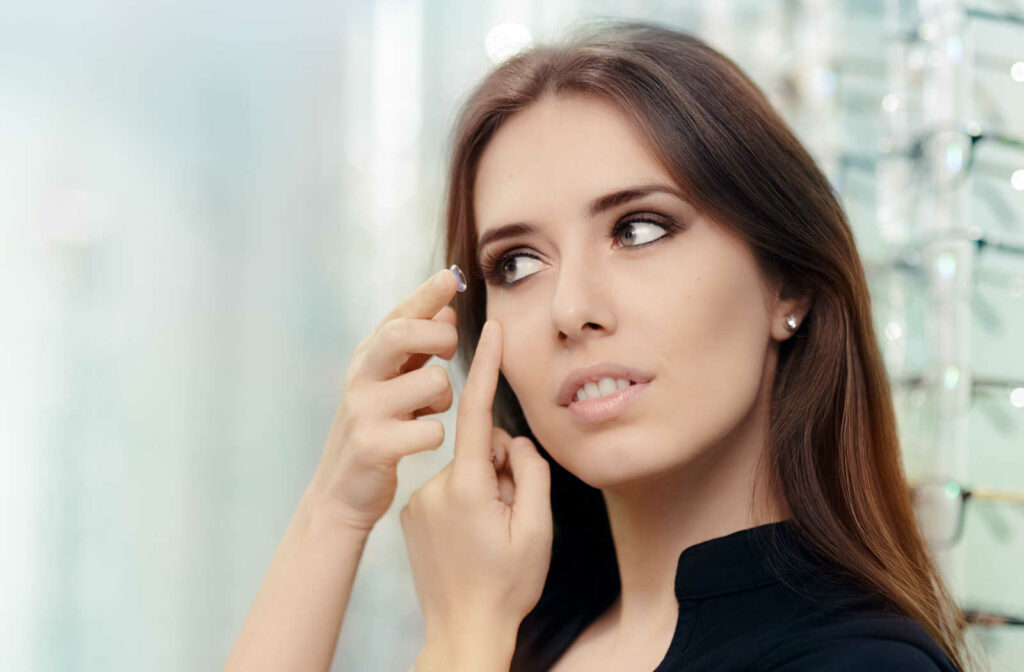When it comes to vision correction, many people can choose between glasses and contact lenses based on their preferences, style, or vision correction needs. However, prescriptions for glasses and contact lenses aren’t interchangeable—your prescription for your glasses isn’t the same for your contact lenses.
Apart from an eye exam to get your glasses prescription, you will also need a contact lens exam for your contact lens prescription.
Understanding Vision Prescriptions
A vision prescription includes various abbreviations and numbers that indicate the lens power required to correct your vision. It’s typically given by an eye care professional, such as an optometrist or ophthalmologist, after conducting a comprehensive eye exam.
Glasses prescriptions are specifically for eyeglasses. They include measurements for each eye and indicate the lens power needed to correct any refractive error, such as nearsightedness, farsightedness, and astigmatism.
Contact lens prescriptions, on the other hand, are specifically tailored for contact lenses. While they also include measurements for each eye, they often have additional information on the specific characteristics needed for contact lenses, such as base curve and diameter.
Differences Between Contact Lenses & Glasses Prescriptions
The main difference between contact lenses and glasses prescriptions is how they correct your vision. When you wear glasses, the lenses sit about 12 millimeters away from your eyes.
Contact lenses sit directly on the surface of your eyes. Their proximity to your eyes affects the lens power needed for correction, making the prescription different from glasses.
Can I Use My Glasses Prescription for Contacts?
While there are some similarities between contact lenses and glasses prescriptions, they are not interchangeable. You cannot simply use your glasses prescription to order contact lenses. This is because the fit and position of the contact lens on your eye are crucial for proper vision correction and eye health.
During a comprehensive eye exam, your eye doctor will test your visual acuity to determine if you need vision correction. They also ensure you have an up-to-date prescription if you already wear glasses.
For those looking to switch from eyeglasses to contact lenses, know that the same prescription doesn’t apply. You will need a contact lens exam and fitting before obtaining a prescription for your contacts.
This exam evaluates your eye health while also considering any eye issues that can prevent you from wearing contact lenses. If you are a candidate, your eye doctor will measure the following to obtain a contact lens prescription:
- Cornea measurements: Mapping your cornea (transparent front part of the eye) helps to determine what type of lens can help improve your vision.
- Base curve (BC): This measures the curvature of the back of the contact lens based on the shape of your cornea. It’s usually a number between 8 and 10.
- Diameter: This specifies lens size or the distance from one side of the lens to the other. Measurements usually include 13 to 15 millimeters.
Your contact lens prescription also identifies the brand or material, including specialty contacts to address eye issues like myopia or dry eye disease. Your contact lens prescription comes with an expiration date which needs updating to account for changes to your vision and to ensure they fit.
Getting the right prescription and proper fit means you can have optimal vision correction and comfort when wearing your contact lenses. Your eye doctor will send you home with a trial pair of contacts to see how well they work for you and train you on lens insertion, removal, and hygiene.
Consulting an Eye Care Professional
It’s important to consult with your eye doctor when considering vision correction options, whether it’s glasses or contact lenses. A thorough eye and contact lens exam can help assess your ocular health and determine your prescription based on your needs and lifestyle.
However, once you have a glasses or contact lens prescription, it doesn’t mean your vision can’t change over time. To maintain clear and comfortable vision and an accurate and customized prescription, visit your eye doctor regularly.
Visit your eye doctor if you experience the following symptoms that can indicate an expired or incorrect prescription:
- Eye strain
- Headaches
- Blurry vision
- Eye infection
Updated Prescriptions for Clear & Comfortable Vision
While contact lenses and glasses prescriptions are related, they aren’t the same. Glasses prescriptions are suited for eyeglasses, while contact lens prescriptions have unique characteristics to ensure the fit of contact lenses to your eyes.
It’s essential to consult with your eye doctor to obtain an accurate prescription for either option. Our mission at Bluebird Vision + Wellness is to help you look and see your best. Schedule an eye or contact lens exam to discuss your vision correction options to meet your vision needs.




